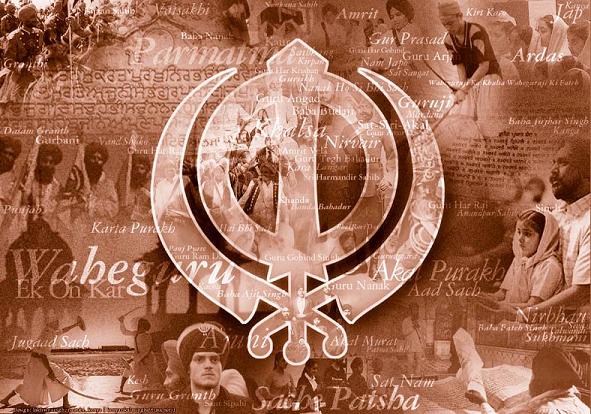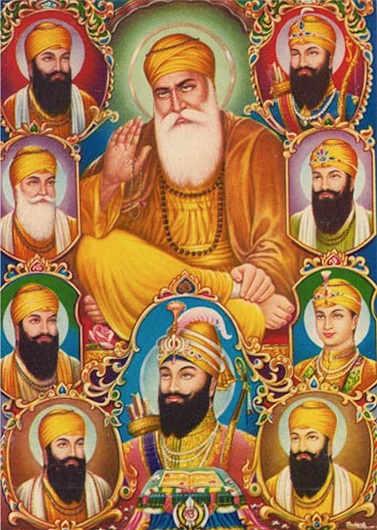ਆਸਾ ( ਮਃ ੧ ) ਗੁਰੂ ਗ੍ਰੰਥ ਸਾਹਿਬ ਅੰਗ ੩੬੦
ਖੁਰਾਸਾਨ ਖਸਮਾਨਾ ਕੀਆ ਹਿੰਦੁਸਤਾਨੁ ਡਰਾਇਆ ॥
Having attacked Khuraasaan, Baabar terrified Hindustan.
ਆਪੈ ਦੋਸੁ ਨ ਦੇਈ ਕਰਤਾ ਜਮੁ ਕਰਿ ਮੁਗਲੁ ਚੜਾਇਆ ॥
The Creator Himself does not take the blame, but has sent the Mugal as the messenger of death.
ਏਤੀ ਮਾਰ ਪਈ ਕਰਲਾਣੇ ਤੈਂ ਕੀ ਦਰਦੁ ਨ ਆਇਆ ॥੧॥
There was so much slaughter that the people screamed. Didn't You feel compassion, Lord? ||1||
ਕਰਤਾ ਤੂੰ ਸਭਨਾ ਕਾ ਸੋਈ ॥
O Creator Lord, You are the Master of all.
ਜੇ ਸਕਤਾ ਸਕਤੇ ਕਉ ਮਾਰੇ ਤਾ ਮਨਿ ਰੋਸੁ ਨ ਹੋਈ ॥੧॥ ਰਹਾਉ ॥
If some powerful man strikes out against another man, then no one feels any grief in their mind. ||1||Pause||
ਸਕਤਾ ਸੀਹੁ ਮਾਰੇ ਪੈ ਵਗੈ ਖਸਮੈ ਸਾ ਪੁਰਸਾਈ ॥
But if a powerful tiger attacks a flock of sheep and kills them, then its master must answer for it.
ਰਤਨ ਵਿਗਾੜਿ ਵਿਗੋਏ ਕੁਤੀਬ਼ ਮੁਇਆ ਸਾਰ ਨ ਕਾਈ ॥
This priceless country has been laid waste and defiled by dogs, and no one pays any attention to the dead.
ਆਪੇ ਜੋੜਿ ਵਿਛੋੜੇ ਆਪੇ ਵੇਖੁ ਤੇਰੀ ਵਡਿਆਈ ॥੨॥
You Yourself unite, and You Yourself separate; I gaze upon Your Glorious Greatness. ||2||
ਜੇ ਕੋ ਨਾਉ ਧਰਾਏ ਵਡਾ ਸਾਦ ਕਰੇ ਮਨਿ ਭਾਣੇ ॥
One may give himself a great name, and revel in the pleasures of the mind,
ਖਸਮੈ ਨਦਰੀ ਕੀੜਾ ਆਵੈ ਜੇਤੇ ਚੁਗੈ ਦਾਣੇ ॥
But in the Eyes of the Lord and Master, he is just a worm, for all the corn that he eats.
ਮਰਿ ਮਰਿ ਜੀਵੈ ਤਾ ਕਿਛੁ ਪਾਏ ਨਾਨਕ ਨਾਮੁ ਵਖਾਣੇ ॥੩॥੫॥੩੯॥
Only one who dies to his ego while yet alive, obtains the blessings, O Nanak, by chanting the Lord's Name. ||3||5||39||
(Translation source: https://www.searchgurbani.com/guru-granth-sahib/ang-by-ang )
The Backdrop
Guru Nanak envisioned Sikhi as an activist faith. Right from the beginning he preached for people to be engaged with the issues of the worldly life by taking righteous positions in the pervasive environment of conflict and strife. The Guru says that no one is free of conflict and strife [1] for conflict is the creation of God like fire, hunger and thirst. [2] Guru Nanak also, during his later years at Kartarpur, was witness to Babar’s invasions that ended up in changing the rule of Hindustan from Lodhis to Mughals.
These were major happenings and the concomitant suffering of people touched the Guru deeply. The Guru’s four compositions popularly known as ‘Babarvani’ give a glimpse of the sense that he makes of these cataclysmic events. These verses are not a historical account but a rendering of the events as the play of divine will in a setting of deep agony and trauma with its mix of sin, blood and tragedy that jolts the conscious of the reader about the tearing effect of the conflict on the body fabric of a society .
The Search
Our endeavor would be to search Babarvani texts for the characterizations of conflict by types as seen by Guru Nanak and explore the lead characteristics the Guru attributes to the types in terms of their ill effects on the society. We would also endeavor to briefly trace the development of the Sikh thought regarding conflict taking off from the enunciation by Guru Nanak and the way this guidance has been used with some familiar examples.
Guru Nanak’s characterization of conflict
Contextual Features
A quick look at the Babarvani compositions suggests that the verse Asa M I, p. 360 provides the context to the events underlying the Babarvani texts and goes on to describe the conflict type and its import. Our primary source therefore is this verse as part of the SGGS. The context as penned by Guru Nanak in this verse is:
Having brought Khurasan under His very protection God dispatched terror to Hindustan.
The Creator Himself does not take the blame, but has sent the Mughal as messenger of death. They slaughtered the screaming people mercilessly.
Did You not feel any compassion, O Lord, he asks?
Guru Nanak was deeply pained by what he saw and goes on to express his anguished view on the conflict saying:
O Creator Lord, You are the Master of all.
If some powerful man strikes out against another man, then no one feels any grief in their mind. ||1||Pause||
But if a powerful tiger attacks a flock of sheep and kills them, then its master must answer for it.
This priceless country has been laid waste and defiled by dogs, and no one pays any attention to the dead.
You Yourself unite, and You Yourself separate; I gaze upon Your Glorious Greatness.
The first part of the above text up to rehao (pause) provides a comment on conflict between two saktas, while the rest of the text deals with the situation akin to a ravenous tiger mauling a herd of sheep. These are two different scenarios and we will look a bit closer at these.
The description of both the scenarios characterizing two different conflict settings has been made by the Guru invoking divine attributes. The Guru therefore has not offered these typologies only as diverse temporal manifestations but as different facets of play of the divine will.
The first case also constitutes part of rehao pankti and is thus central to the shabad, or relatively a more defining character of the societal dynamic. The second typology inheres the oppression of people and laying the land to waste.
Matched Contest Typology
The first situation the Guru addresses is where a powerful entity attacks another powerful entity: If some powerful man [sakta] strikes out against another man, then no one feels any grief in their mind. The key term sakta is derived from shakti literally meaning power. This term has been used by Guru Nanak for God in the SGGS and therefore sakta should not suggest a judgmental connotation. Within that frame, sakta here could be contesting with another sakta in the course of life and should not provoke ros – resentment - anger to arise.
If we look a bit closer, we use sakta taking on sakta as a tool for teaching life skills. Most of our training and education to help develop life skills simulate competitive scenarios through sporting activities, debates, excellence tests, reality plays et al. The contestant’s ability and drive to go for a win is cultivated in a positive and ethical frame with intent to outperform the opponent within the rules of engagement. Its negative manifestation could be a deeply egotist sakta or worse a megalomaniac despot. It happens as will see in the Guru’s next typology.
Tiger Mauling the Sheep Typology
The other situation has been described by the Guru saying:
But if a powerful tiger [sakthaa seehu] attacks a flock of sheep and kills them, then its master must answer for it.
He uses the simile of a powerful tiger – sakta sinh – that emasculates a vulnerable animal in the wild, not to satisfy his hunger, but to terrorize and assert his supremacy in that territory. Such situations arise out of our base instincts and significantly Babar is likened to an egotistical worm by Guru Nanak further on [3] .
For this kind of conflict situation, the Guru says that the accountability is that of the master, who orders, abets or instigates the conflict rather than the ones who may be carrying out his nefarious designs. In another way this mostly happens in no-contest situations and perhaps that explains its being the most common disruption witnessed in societal peace and harmony.
The above enunciation flows out of the underlying narrative in Babarvani texts. The readers will benefit by reading the linked verses at Asa M I, p. 417/11, p. 417-8/12 and Tilang M I, p. 722.
Developing Sikh thought on conflict
Guru Nanak in the very vast canvas of his writings has touched variously on conflict in society of his time. Babarvani texts by Guru Nanak however break new ground in the understanding of conflict and identify two clear typologies of conflict, discussed earlier in this paper.
Guru Hargobind institutionalized the Sikh imperative of righteous response to provocation – a call to aachaar with veechaar.Aachaar means lifestyle, way of life, action choices and character. Veechaar is to contemplate, reflect, or judge.
Guru Gobind Singh refined it further. He clarified that veechaar needed a trigger to turn into the aachaar mode and the trigger was ros (resentment, anger). He has written that when edge of the arrow touched my body, it kindled my resentment’ [4] and the Guru joined the battle actively.
Guru Gobind Singh also defined the principles for joining the conflict. He says in Zafarnama [5] to Aurangzeb that it is not chivalry that in war countless hosts pounce upon just a few on opposing side. (41) At that stage one can join battle to fight the aggressors, (21) or if situation is past every other remedy it is righteous to unsheathe the sword to defend and to dispel the aggressor. (22) If the situation is otherwise, have nothing to do with the battle. (23)
Many verses of Zafarnama would resonate with Babarvani text, witness: Do not hurt or molest those who had not aggressed against you. (28) Bravery does not consist in putting out a few sparks and in the process stir up a fire to rage all the more! (79) God could not have wished for a King to create strife but instead to promote peace, harmony and tranquility among the people. (65) Nor should the ruler use his strength, power and resources to harass, suppress or deprive the weak. This will only weaken the society, erode his ability to rule effectively and make the State unsafe. (109) He should not recklessly shed blood of others lest heaven’s rage should befall him. (69)
Guru Gobind Singh’s instructions to Banda Bahadur to punish those responsible for acts of the oppression and injustice unleashed on Sikhs were according to Guru Nanak’s advisory. The Guru was doubtlessly using the same logic when he asked Aurangzeb what could have been achieved by killing his four tender sons, when he [the master], like a coiled snake remained behind. (78)
Examples & experience
Limiting ourselves to confrontation using force to oust the adversary from position of power, the 1947 Sikh experience seems to support the first typology. It was a bitter fight as long as it lasted but the ros dissipated on both sides soon enough and has stayed that way.
The second typology is commonplace in developing societies where often the police and armed forces have been alleged to have used excessive force on unarmed, peacefully protesting civilian population against cases of hate crimes, lynching, rape and molestation of women.
This typology fits the Pogrom against Sikhs in Delhi after the assassination of PM Indira Gandhi by two of her Sikh security guards. For the next three days Delhi became a hunting ground where organized mobs went around killing Sikhs, while Police silently stood by and civil administration took no action to stem the violence.
While there has been mention about complicity of the Political and Government agencies in the pogrom, none of the senior functionaries has been held responsible and punished nor have Sikhs invoked the advisory of Guru Nanak holding the master accountable. It may not have helped but some effort at creating legislation fixing responsibility on lapsing officials, would have raised the profile of awareness about the imminent need of the measure pronounced by the Guru.
Contemporary scene and conclusion
While the research into types of conflict and peace studies is afoot in most societies, we seem to be at a stage when new modes of pursuing conflict are outpacing the development of strategies to manage their known causes. The fundamental twin typology that was talked of by Guru Nanak is still the same, though I doubt if it ever has been presented at any forum focused on problems of peace and harmony in society.
There is significant Sikh involvement in peace and societal harmony related initiatives by variety of interfaith and multicultural groups in the Western Diaspora. [6] Sikhs, as a community, do have to cope with situations of unequal power or clout against the mainstream agencies and organs of power elite in all societies because of limited resource pool. We, in our own interest, should be propagating the wise counsel of Guru Nanak to help reduce incidents of mob violence, rape, hate crimes and identity based offences which are everyday occurrences while those who abetted the crime roam free.
The Guru also sees situations in life when conflict cannot be avoided or may be preferred choice to contain a pervasive ill. The paradox is that any uncontrolled force can turn into an evil, worse than the force it contained. So use of force must be carefully calibrated for it takes little time for the wardens of peace to turn rapists and killers.
Needless to emphasize again that this subject has not received the kind of attention it needs from the Sikhs. Our hope is that it will begin to happen so that Sikhs can play their part to help usher in improved justice, peace and harmony through judicial activism in the societies they live in.
[1] Bin bāḏ biroḏẖėh ko▫ī nāhī -– Maru M I, p. 1025
[2] Agan upā▫ī vāḏ bẖukẖ ṯihā▫i▫ā – Var Malar ki, M I, p. 1282
[3] jae ko naao dhharaaeae vaddaa saadh karae man bhaanae khasamai nadharee keerraa aavai jaethae chugai dhaanae – Asa M I, p. 360
[4] Jabai baan laagyo Tabai ros jaagyo – Dasam Granth, p. 148
[5] The numbers in parenthesis are verse numbers of the Zafarnama text – original in Persian.
[6] For a more comprehensive treatment, read Author’s book, Interfaith Engagement – full text of the book can be accessed at http://www.sikhsandsociety.org/Interfaith%20Engagement%20Text.pdf
© Copyright Prof. Nirmal Singh
Orlando, FL
Camp, New Delhi
4 August, 2019
Prof. Nirmal Singh has been associated with many faith, interfaith and multi cultural initiatives for several years to share information about Sikh faith, culture and values. His six books, several articles and conference papers often explore the Sikh interface with civil Society.
Please acknowledge quotations from this articleArticles may be published subject to prior approval by the author


